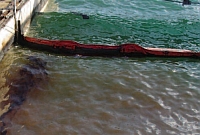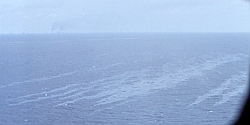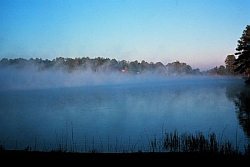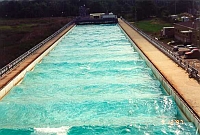Supplement 2.5: Weathering of Oil on the Water Surface (1/4)
- Physical Processes -
1. Spreading
As soon as oil is spilled, it starts to spread over the sea surface into a film which may be very thin. Thus a small quantity can cover a large surface area (1000 litres of oil may cover 1 km3). The speed at which the oil spreads depends to a great extent on its viscosity ("thickness") and the volume spilled. Low viscosity ("thin") oils spread more quickly than those with a high viscosity ("thick oils"). Other than oil drops in the salad dressing, oil spills at sea tend to form narrow bands parallel to the wind direction (see photo). These oil bands are subjected to winds, wave action and water turbulence. Tidal streams and currents also influence the spreading of an oil spill.
2. Evaporation
The light (volatile) fractions of oil begin to evaporate immediately after a spill, and may continue to do so for a long time. The rate and duration of evaporation depends mainly on the volatility of the oil, but also on the amount spilled and the weather conditions (wind speed, air and water temperature, water turbulence).
3. Natural Dispersion
Natural dispersion induced by waves and turbulence at the sea surface may cause an oil spill to break up. A continuous oil film may thus be broken up into droplets of varying sizes. These oil droplets not only swim on the sea surface but also mix up with the upper layers of the ocean water. If the sea is calm, the oil is most likely to form large slicks making it easier to detect and clean up the spill.

Photo: OHMSETT
Dispersion may eventually lead to the formation of water-in-oil emulsions.



